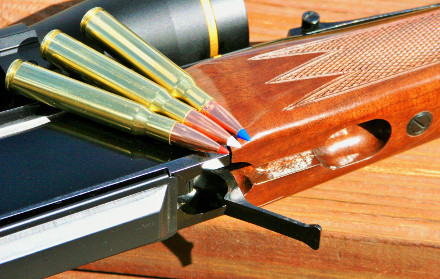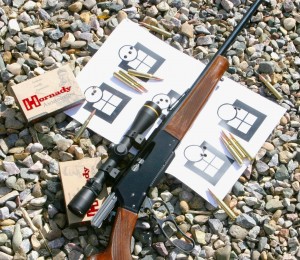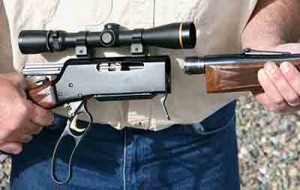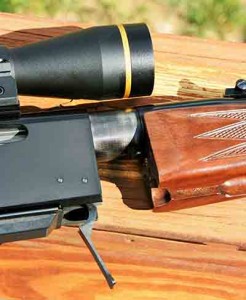
Do takedown rifles really work? Can they shoot as well as “normal” rifles? Did Browning go too far by modifying the classic BLR to offer a takedown version? The answer to these questions is both YES and NO. Read on to find out more on the new Browning BLR Takedown lever action rifle.
There is hardly a better rifle style for carrying in the hand than the Browning BLR. For me, grasping it in my right or left hand around the bottom of the magazine results in a well-balanced carry, which is very comfortable for even long periods of time. I have owned, shot, and hunted with BLRs in .257 Roberts and the 308 and 358 Winchester cartridges. There is something about working the smooth lever that just feels right when out in the woods on a cool, crisp fall morning. The great strength of the action design also allows for chambering in modern higher pressure rounds, and the detachable magazine allows for shooting the more ballistically efficient spire point bullets.
The only aspect of the BLR that annoys is cleaning the barrel from the muzzle, since pulling the lever and bolt is not recommended. The capability of a very fast follow up shot, due to the smoothness of the lever action, does overshadow the minor cleaning inconvenience. When Browning introduced the new Takedown version, I was eager to give it a try. My test rifle was requested in the classic .30-06 chambering in order to allow me to test it for accuracy with a broad variety of factory ammunition and handloads..
Chapter 1: How Did They Do It?
Click to LOAD DATA SHEET
The new takedown version uses the same bushing on the rear of the barrel, but it instead is a very snug slip fit into the receiver.
Browning engineers are to be recognized for coming up with a very simple solution to offering a takedown version of the BLR. The standard model has the bolt rotating lugs locking up into a steel bushing pressed onto the rear of the barrel, which is then pressed into the top, front of the receiver. The new takedown version uses the same bushing on the rear of the barrel, but it instead is a very snug slip fit into the receiver. One single cross pin, just in front of the magazine release, supports an eccentric cam that...
drives a gate up into a cross slot milled into the bottom front edge of the barrel bushing.
To remove the barrel/forend as an assembly, simply pull down and back about 90 degrees on the retention lever located just in front of the magazine release. This movement rotates the cam, which in turn causes the attached gate to slide down slightly from its top locked position. Then grab the barrel/forearm assembly and pull it straight out. The lever should first be worked slightly to cause the bolt to unlock from the steel barrel bushing.
Reassembly is just as simple as inserting the assembly bushing fully into the receiver and snapping the release lever back up and forward into place. Removal or installation takes only about 5 seconds. So, for only a few dollars more (around $70), the addition of less than a half dozen parts and the milling of a retention groove in the barrel bushing, a hunter can now have a takedown version of the BLR. This allows for easy cleaning from the rear and the ability to pack a long (or short) actioned lever gun in a very easy to transport package no longer than the barrel.

Also offered is a Scout type scope mounting base, which replaces the rear sight to allow for the alternate mounting of an intermediate eye relief scope. So mounted, removing and replacing the barrel would not have any effect on the zero, as the scope is mounted to the barrel. But how would the zero be impacted if a hunter wanted to stay with a traditional scope mounted to the receiver? Can a takedown lever gun be accurate? To find out, I assembled 9 representative factory loads, and I also rounded up 10 proven bullets to test with handloads. Performance was tested by firing five, 3-shot groups at 100 yards.
Chapter 2: Factory Ammunition Accuracy
The Takedown was tested with 4 Federal factory loads and 5 from Hornady. I mounted a Leupold Vari-X III in 2.5-8 power on the test rifle, one of my personal favorite hunting scopes. Right from the beginning, it was apparent that this rifle was capable of very good hunting accuracy. The 150 grain Hornady BTSPs averaged 0.90” for five, 3-shot groups, at a speed of 2,813 fps. In the slightly heavier 165...
grain class, velocities ran from 2,788 to 2,810 fps, with groups averaging from 1.12 to 1.61”. The more traditional 180 grain bullets shot into 1.19, 1.38 or 1.42” with speeds running from 2,615 fps up to an impressive 2,791 fps for the Federal load using the Barnes MRX bullet. I found performance (group size) was best when the barrel was allowed to fully cool between groups.

Does removing and reinstalling the barrel seriously impact the point of impact on the Takedown BLR? When factory ammo accuracy testing was completed, I went back to using the Hornady 150 grain factory round for the point of impact test. What did I find? Virtually, a negligible change of impact when firing 3 shots, letting the barrel cool, pulling and reinstalling the barrel, and then firing another group. The greatest point of impact I ever saw was less than ¾” deviation from the prior group. So a hunter in pursuit of deer, elk, boar, moose, or bear, out to 200 yards or more, need not worry about where his rifle will hit, if the barrel had been removed for easy transport or cleaning.
Chapter 3: Handloads in a Takedown
Long ago, I discovered that the greatest variation in accuracy will not come from switching from 52 to 53 grains of a given powder, but from changing from one powder type to another. Generally, I am able to achieve very respectable groups from most rifles because I am willing to try from 6 to 10 or more types of powder with any given bullet. That does not mean that I fire fifteen or twenty rounds with each load, but only that I first try one or two groups, with perhaps a dozen different powders, and then load and reshoot the loads that displayed the best accuracy.
During rifle accuracy testing, I always want to see how well the rifle would perform, if it were MY rifle.
For these handloading tests, I first tried around sixty powder and bullet combinations and then proved the performance of the best shooting ones by confirming with five, 3-shot groups. Charges were thrown and weighed using the RCBS ChargeMaster powder dispensing system. The QuickLOAD ballistic program, as well as referencing...
manufacturer’s manuals, was the starting basis for load development.
All handloads featured Winchester brass and Federal 210 Large Rifle primers. The bullets tested included known performers from Barnes, Hornady, and Nosler. Weights included 130, 150, 165, 180, 200, and 220 grains to allow for greater hunter versatility on broad types of game. The bottom line is, I wanted to see how well this Browning could shoot if I really gave it a fair and thorough test. Of course, it would have been easier to just open up a few manuals and try one or two powders with each bullet, but what would you or I have learned from such a limited test? During rifle accuracy testing, I always want to see how well the rifle would perform, if it were MY rifle.
It is very remarkable that a takedown lever gun is capable of shooting a broad variety of handloads into around only an inch at 100 yards.
The fourteen listed handloads are the result of trying and retesting over sixty different combinations. The very first load I tried with the 130 grain Barnes TSX used IMR 4895, and it rewarded me with 0.95” groups, at almost 3,200 fps. This would be a great load for deer or pronghorn at moderate to long range. The same powder also shot well with the 150 grain Hornady InterBond bullet and the 165 grain Nosler Partition, for 2,964 fps and 2,826 fps respectively, with both grouping just over an inch. Ramshot Big Game shot very well with the Barnes 165 grain TSX or the 180 grain Hornady InterBond.

Vihtavuori N550 produced 1.09” groups at 2,746 fps with the Barnes 180 grain MRX bullet. Three other powders, IMR 4350, Hodgdon H380, and Winchester 760 gave almost identical performance with the Hornady 180- InterBond. In fact, this bullet was the least sensitive one tested as far as not being particular about which powders gave very good accuracy from the Browning. The newer Nosler 180 grain AccuBond shot very well with either Accurate 4350 or N550 producing around 2,800 fps. I also included two heavyweights in my testing, the 200 and 220 grain Nosler Partitions, as well as the traditional 220 grain Hornady round nose. The lighter...
Nosler liked 760 powder; the heavier one, Big Game. N560 turned in the best accuracy under the 220 Hornady soft points.
From the 130 or 165 grain Barnes TSXs, to the 150 or 180 grain Hornady InterBonds, up to the 220 grain bone-crushing Nosler Partition or Hornady round nose, a serious hunter can find a load that will give outstanding field performance from antelope to moose, or African plains game. It is very remarkable that a takedown lever gun is
capable of shooting a broad variety of handloads into around only an inch at 100 yards.
Chapter 4: Summary
The Takedown BLR is available in a broad range of calibers suitable for hunting most all game throughout the world. The simplicity of the Browning takedown feature has to be seen to be believed. Besides allowing for very easy barrel cleaning, the takedown feature makes for convenient transport and packing in or to the hunting field.
If Browning were to offer interchangeable barrels, they really would have the attention of a lot of hunters. Imagine going from a .22-250 for wolves, to a 7mm-08 for deer, to a .358 for wild boar, all with the same rifle? How about a .270 and .35 Whelen combo? Or you could have a 300 WSM and a 450 Marlin package carried in a small, inconspicuous hard or soft case. One rifle, with which the shooter is so familiar, makes a lot of sense for a seasoned hunter. Now that would be something to put on your Christmas wish list!